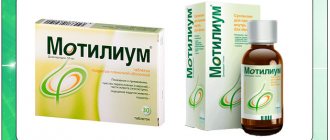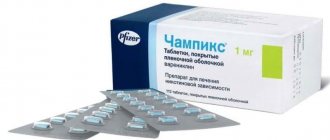The drug belongs to the group of blood thinners. The active ingredient is dabigatran, it blocks thrombin, preventing the formation of a blood clot. Used to prevent thrombosis after joint surgery, atrial fibrillation, and atrial fibrillation. It is also used for the treatment of pulmonary embolism and blockage of deep veins.
Indications for use of Pradaxa
The capsules of the drug contain dabigatran etexilate, which immediately after absorption through the walls of the digestive system turns into the active substance - dabigatran. It blocks the action of thrombin at several levels:
- reduces the activity of free enzyme circulating in the blood;
- inhibits thrombin, which binds fibrin filaments;
- inhibits platelet aggregation.
Red thrombus - red blood cells in a fibrin network
Since under the influence of thrombin, fibrinogen in the blood plasma is converted into fibrin threads, stopping this process prevents the formation of blood clots. As a result, blood clotting is reduced, this can be used in the following situations:
- prosthetics of knee and hip joints (to prevent thrombosis);
- atrial fibrillation – prevention of ischemic stroke, thromboembolism, myocardial infarction;
- reducing mortality from heart and vascular diseases caused by a high risk of thrombosis;
- thrombosis of venous vessels, acute or continuously recurrent form;
- pulmonary embolism.
We recommend reading the article about the drug Warfarin. From it you will learn about the composition of the tablets, indications for use and contraindications, as well as side effects and how to use the drug during pregnancy and breastfeeding.
And here is more information about first aid for heart pain.
pharmachologic effect
Anticoagulant. Direct thrombin inhibitor. Dabigatran etexilate is a low molecular weight prodrug that does not have pharmacological activity. After oral administration, it is rapidly absorbed and is converted into dabigatran by hydrolysis catalyzed by esterases.
Dabigatran is an active, competitive, reversible direct thrombin inhibitor and acts primarily in plasma.
Since thrombin (serine protease) converts fibrinogen into fibrin during the coagulation cascade, inhibition of its activity prevents the formation of a blood clot. Dabigatran inhibits free thrombin, fibrin-binding thrombin, and thrombin-mediated platelet aggregation.
In vivo and ex vivo animal studies using various thrombosis models have demonstrated the antithrombotic efficacy and anticoagulant activity of dabigatran after intravenous administration and dabigatran etexilate after oral administration.
A close correlation was found between the plasma concentration of dabigatran and the severity of the anticoagulant effect. Dabigatran prolongs the activated partial thromboplastin time (aPTT).
Contraindications
Pradaxa should not be prescribed if there is an established intolerance to the active substance or auxiliary components, as well as in the presence of the following diseases:
- marked decrease in kidney function;
- intense bleeding (gastric, uterine, pulmonary, intestinal, hemorrhoidal);
- ulcerative defect in the stomach or intestines;
- malignant neoplasms;
- acute period after injury (surgery) of the brain or spinal cord;
- surgical interventions on the eyes;
- bleeding in the brain;
- varicose veins of the esophagus;
- vascular aneurysm;
- malformation of arteries and veins;
- diseases of the spinal cord and brain with a risk of bleeding;
- presence of an artificial heart valve;
- liver pathology.
It is not recommended to combine Pradaxa with drugs that reduce blood clotting. Ketoconazole and itraconazole for the treatment of fungal infections of internal organs are not compatible with the drug, as well as cyclosporine (a cytostatic agent).
Under the influence of Pradaxa, blood clotting decreases
Caution is required when prescribing Pradaxa to patients who have potential risk factors for bleeding:
- over the age of 75;
- for kidney diseases;
- low body weight (up to 50 kg);
- taking any drugs that reduce blood clotting, including Aspirin, Clopidogrel, any non-steroidal anti-inflammatory drugs;
- congenital tendency to bleeding;
- decrease in platelets or their functional inferiority;
- recent injury or surgery, biopsy;
- endocarditis due to bacterial infection;
- reflux disease (reflux of gastric juice from the stomach into the esophagus);
- inflammation of the esophagus or gastric mucosa.
Compound
Pradaxa is sold from pharmacies in the form of capsules for oral administration. The tablets have an oblong shape, a soft shell with a creamy swelling. The main active trace element of the drug is dabigatran etexilate.
You may be interested in: Keller's disease: causes, symptoms and treatment
The drug is produced in several dosages - 75, 100, 150 milligrams. In addition to the active ingredient, Pradaxa also contains additional substances:
- gum arabic;
- hypromellose;
- liquid silicone;
- wine acid;
- indigo carmine;
- amphoteric tetravalent titanium oxide;
- carrageenan;
- potassium chloride.
Capsules are distributed in blisters of ten pieces or in polyethylene bottles of sixty pieces. One package can contain one, three or six blisters.
Use of tablets
Before starting treatment, patients must be examined:
- general blood test;
- coagulogram;
- blood biochemistry with kidney and liver tests;
- creatinine clearance to assess the filtration capacity of the kidneys;
- general urine analysis.
The same diagnostic methods, and, if necessary, ultrasound of the abdominal organs, are carried out throughout drug therapy, since if signs of impaired liver and kidney function or an excessive drop in blood coagulation ability appear, dose adjustment or discontinuation of the drug may be required.
If there is a tendency for blood hemoglobin and blood pressure to drop, then the source of possible blood loss must be identified.
Pradaxa capsule in the required dose should be taken at the same time every day once or twice a day.
The timing of meals does not affect the absorption of the drug; it must be taken into account that when the capsular membrane is opened, the activity of the drug almost doubles, this may increase the risk of internal bleeding.
If a dose is missed, then continue to take the medication the next day without doubling the number of capsules.
Reviews
We have selected some reviews from people who have used Pradaxa:
- Elena. This remedy was prescribed to me after hip surgery. I have been taking it for the fifth month now, according to reviews from many patients, the drug begins to work after two weeks, it helped me after a month of use. The pain is gone. Although treatment is expensive, it takes 2 packages per month, but there is a positive result.
- Sasha. After suffering a DVT in the left leg, after being discharged from the hospital, the blood thinner Prodaxa 110/2 r.d. was prescribed to resolve blood clots. After taking the first tablet there were traces of blood in the urine, after taking the second in the morning there was severe hematuria. Stopped drinking. A week on cardiomagnetic. I decided to try Prodaxa again, the result was the same - severe hematuria. BUFFLO for 3000 rub. Acetone is probably less harmful...
- Maria. I have been taking the drug twice a day due to constant arrhythmia for three years now. I feel good, the medicine supports the body well and prevents blood clotting. Although the product is expensive for pensioners, it is effective. The only thing I want to advise other patients is to drink it with food so that their stomach does not hurt.
- Danil. I have been familiar with this drug for 5 years now and am convinced that it is very effective. The drug is not cheap, but it helps well, significant improvements are noticeable. I am very grateful to the doctor who prescribed Pradaxa. You can buy it in almost every pharmacy; if it is not there, you can order it. But it is also very important to choose the right dosage. The annotation says that internal bleeding is possible, I have never encountered this, but since it is written, it can happen. I recommend using this drug, it is better than analogues.
When to choose what dosage - 110, 150 mg
Pradaxa has three release forms - capsules of 75, 110 and 150 mg. Only a specialist can recommend a specific dose. There are several treatment rules:
- After replacing a hip or knee joint with a prosthesis, 2 - 3 hours after completion of the operation, the patient takes 1 capsule (110 mg), and from the next day drinks 2 capsules (220 mg in total) for 10 days to 1 month.
- If the patient has moderate renal impairment, then he is recommended to take 1 capsule of 150 mg or 2 capsules of 75 mg for a single dose throughout the course of treatment.
- Dose adjustment (orthopedics) downward to 150, 110 or 75 mg is required for the elderly and patients prescribed Verapamil, Amiodarone.
- To prevent stroke, blockage of veins, pulmonary artery, a daily dose of 300 mg is used, divided into 2 doses. Therapy is long-term, in many cases lifelong.
- A lower dose for vascular pathology is 220 mg, it is indicated for elderly patients, as well as people at high risk of blood loss.
Pharmacokinetics
Suction
After taking the drug, the pharmacokinetic profile of dabigatran in the blood plasma of healthy volunteers is characterized by a rapid increase in plasma concentration with Cmax achieved within 0.5-2 hours.
After reaching Cmax, plasma concentrations of dabigatran decrease biexponentially, the final T1/2 averages about 14-17 hours in young people and 12-14 hours in elderly people. T1/2 does not depend on dose. Cmax and AUC vary proportionally to the dose. Food does not affect the bioavailability of dabigatran etexilate, but Tmax is delayed by 2 hours.
The absolute bioavailability of dabigatran is about 6.5%.
A study examining the absorption of dabigatran etexilate 1-3 hours after surgery demonstrated a slower absorption compared to healthy volunteers. A smooth increase in AUC without the appearance of Cmax in plasma was revealed. Cmax was observed at 6 hours after administration or at 7-9 hours after surgery. It should be noted that factors such as anesthesia, gastrointestinal paralysis and surgery may play a role in slowing absorption, regardless of the dosage form of the drug. Another study showed that slow absorption or delayed absorption is usually observed only on the day of surgery. In the following days, absorption of dabigatran occurs rapidly, reaching Cmax 2 hours after administration.
Distribution
A low ability (34-35%) of binding of dabigatran to human plasma proteins has been established, regardless of the concentration of the drug. The Vd of dabigatran is 60-70 L and exceeds the volume of total body water, indicating a moderate distribution of dabigatran in tissues.
Metabolism and excretion
After oral administration of dabigatran etexilate is quickly and completely converted to dabigatran, which is the active form in plasma. The main route of metabolism of dabigatran etexilate is hydrolysis catalyzed by esterases, which converts it to the active metabolite dabigatran.
When dabigatran is conjugated, 4 isomers of pharmacologically active acyl glucuronides are formed: 1-O, 2-O, 3-O, 4-O, each of which constitutes less than 10% of the total dabigatran content in plasma. Traces of other metabolites were detected only using highly sensitive analytical methods.
The metabolism and elimination of dabigatran were studied in healthy volunteers (men) after a single intravenous administration of radiolabeled dabigatran. The drug was excreted mainly through the kidneys (85%) unchanged. Excretion in feces was about 6% of the administered dose. Within 168 hours after administration of the drug, the removal of total radioactivity was 88-94% of the dose used.
Pharmacokinetics in special clinical situations
In volunteers with moderate renal impairment (creatinine clearance 30-50 ml/min), the AUC value of dabigatran after oral administration was 2.7 times higher compared to subjects with normal renal function. In severe renal failure (creatinine clearance 10-30 ml/min), the AUC value of dabigatran and T1/2 increased by 6 and 2 times, respectively, compared with patients without renal failure.
Compared with young people, in elderly patients the AUC and Cmax values increased by 40-60% and 25%, respectively. In population pharmacokinetic studies involving elderly patients up to 88 years of age, it was found that with repeated doses of dabigatran its content in the body increased. The observed changes correlated with an age-related decrease in creatinine clearance.
In 12 patients with moderate hepatic impairment (Child-Pugh class B), there were no changes in dabigatran levels compared to controls.
Population pharmacokinetic studies assessed pharmacokinetic parameters in patients weighing 48 to 120 kg. Body weight had little effect on plasma clearance of dabigatran. Its content in the body was higher in patients with low body weight. In patients weighing more than 120 kg, there was a decrease in the effectiveness of the drug by approximately 20%, and with a body weight of 48 kg, an increase of approximately 25% compared to patients with average body weight.
Phase 3 clinical studies showed no differences in the efficacy and safety of Pradaxa ® in men and women. In women, exposure to the drug was 40-50% higher than in men, but no dose adjustment was required.
A comparative study of the pharmacokinetics of dabigatran in Europeans and Japanese after a single and repeated dose of the drug in the studied ethnic groups did not reveal clinically significant changes. Pharmacokinetic studies have not been conducted in blacks.
Possible adverse drug reactions
The most common complication of using Pradaxa, as with all medications that reduce blood clotting, is a high risk of bleeding - intracranial, postoperative, gastrointestinal, hemorrhoidal, urinary tract, nasal, uterine cavity. In addition, common side effects include:
- decrease in hemoglobin, red blood cells and platelets;
- skin itching, rashes;
- bronchospasm;
- release of bloody sputum when coughing;
- stomach ache;
- difficulty swallowing;
- nausea, diarrhea;
- pain and heaviness in the right hypochondrium, increased bilirubin in the blood;
- the occurrence of bruising on the skin.
Use during pregnancy
Clinical studies on the effect of Pradaxa on the course of pregnancy and fetal development have not been conducted; therefore, there is no data on the presence or absence of a risk for this category of patients. In such cases, the drug is not prescribed during this period.
If there is a possibility of pregnancy, women are advised to use reliable methods of protection to eliminate the potential danger; in case of confirmed gestation, Pradaxa should be discontinued. An exception may be when the drug is used for health reasons.
Analogs
The pharmacological industry offers drugs similar in composition and active ingredients, but they should be used only as prescribed by a doctor. The closest in composition are:
- Warfarin is an antithrombotic drug from the group of anticoagulants. Reduces the risk of blood clots and is used in the treatment of vascular pathologies.
- Lavenum is a medicine with anti-inflammatory and antithrombotic effects. Prescribed for thrombophlebitis of superficial veins, injuries, bruises.
- Fluxum is the active component of the drug - sodium parnaparin. Most often used in hospital settings for intravenous administration.
- Emeran - has an anti-inflammatory and antithrombotic local effect, can be prescribed in combination with other drugs for the treatment of diseases of the veins and blood vessels.
Before using analogues, consult your doctor.
Cost of Pradaxa capsules
Prices for the drug may have the following fluctuation ranges:
| Dosage | № | Price in Rubles |
| 75 mg capsules | №10 | from 584 to 605 rubles |
| №30 | from 1780 to 1870 rubles | |
| 110 mg capsules | №10 | from 660 to 675 rubles |
| №30 | from 1645 to 1699 rubles | |
| №60 | from 2995 to 3150 rubles (965-1170 hryvnia) | |
| 150 mg capsules | №30 | from 1650 to 1710 rubles |
| №60 | from 2995 to 3200 rubles (980-1110 hryvnia) |
Dispensing from pharmacies is carried out only upon presentation of a doctor's prescription.
Vacation conditions and price
The average cost of Pradaxa (75 mg tablets No. 30) in Moscow is 1980 rubles. In the pharmacy chain, capsules are sold only with a doctor's prescription. It is not recommended to use them independently or on the advice of a non-specialist.
After opening the bottle of capsules, they should be used within 4 months. The shelf life of the medicine is 3 years. The instructions for use for Pradaxa capsules require that they be stored in the original original packaging, protected from light and humidity, and out of the reach of children, at an air temperature not exceeding +25° C.
Post Views: 120








